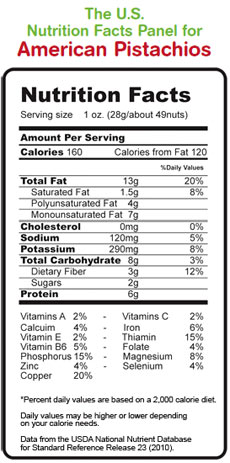|
|
Health Benefits of Green Pistachio: A Miracle Nut
 The
pistachio, Pistacia vera in the Anacardiaceae family, is a small tree originally
from Greater Iran which now can also be found in regions of Syria, Lebanon,
Turkey, Greece, Tunisia, Kyrgyzstan, Tajikistan, Turkmenistan, India, Pakistan,
Egypt, Italy (Sicily), Uzbekistan, Afghanistan especially in the provinces of
Samangan and Badghis, and the United States, specifically in California. The
tree produces an important culinary nut. The
pistachio, Pistacia vera in the Anacardiaceae family, is a small tree originally
from Greater Iran which now can also be found in regions of Syria, Lebanon,
Turkey, Greece, Tunisia, Kyrgyzstan, Tajikistan, Turkmenistan, India, Pakistan,
Egypt, Italy (Sicily), Uzbekistan, Afghanistan especially in the provinces of
Samangan and Badghis, and the United States, specifically in California. The
tree produces an important culinary nut.
Pistacia vera often is confused with other species in the genus Pistacia that
are also known as pistachio. These species can be distinguished from P. vera by
their geographic distributions in the wild and their nuts. Their nuts are much
smaller, have a strong flavor of turpentine, and have a shell that is not hard.
Archaeologists have found evidence from excavations at Jarmo in northeastern
Iraq that pistachio nuts were a common food as early as 6750 BC. The Hanging
Gardens of Babylon were said to have contained pistachio trees during the reign
of King Merodach-Baladan about 700 BC. The modern pistachio nut P. vera was
first cultivated in Western Asia, where it has long been an important crop in
cooler parts of Iran and Iraq. It appears in Dioscurides as pistakia πιστάκια,
recognizable as P. vera by its comparison to pine nuts. Its cultivation spread
into the Mediterranean world by way of Iran from Syria.
The bush grows up to 10 metres (33 ft) tall. It has deciduous pinnate leaves
10�20 centimeters (4�8 inches) long. The plants are dioecious, with separate
male and female trees. The flowers are apetalous and unisexual, and borne in
panicles.
The fruit is a drupe, containing an elongated seed, which is the edible
portion. The seed, commonly thought of as a nut, is a culinary nut, not a
botanical nut. The fruit has a hard, whitish exterior shell. The seed has a
mauvish skin and light green flesh, with a distinctive flavor. When the fruit
ripens, the shell changes from green to an autumnal yellow/red, and abruptly
splits part way open . This is known as dehiscence, and happens with an audible
pop. The splitting open is a trait that has been selected by humans. Commercial
cultivars vary in how consistently they split open. Each pistachio tree averages
around 50 kg of seeds, or around 50,000, every two years.
In research at Pennsylvania State University, pistachios in particular
significantly reduced levels of low-density lipoprotein (LDL cholesterol) while
increasing antioxidant levels in the serum of volunteers. In rats, consumption
of pistachios as 20% of daily caloric intake increased beneficial high-density
lipoprotein (HDL cholesterol) without lowering LDL cholesterol, and while
reducing LDL oxidation.
Consuming unsalted, dry-roasted pistachios prevents any addition of unwanted
fats and additional sodium in the diet that may affect cardiac health adversely
and increase hypertension. Human studies have shown that 32�63 grams per day of
pistachio nut can significantly elevate plasma levels of lutein, alpha-carotene,
beta-carotene, and gamma-tocopherol. In December 2008, Dr. James Painter, a
behavioral eating expert, professor and chair of School of Family and Consumer
Sciences at Eastern Illinois University, described the Pistachio Principle. The
Pistachio Principle describes methods of "fooling" one's body into eating less.
One example used is that the act of shelling and eating pistachios one by one
slows one's consumption, allowing one to feel full faster after having eaten
less.
Pistachio importance in women health
 An important way for women to keep fit is to reduce the risk factors for health
problems that they face. Maintaining a healthy heart and blood vessels is one of
the most important things a woman can do. Several studies suggest that including
pistachios as a part of a well-balanced diet helps support healthy cholesterol
levels. Read more about the science showing the heart health benefits of
pistachios. An important way for women to keep fit is to reduce the risk factors for health
problems that they face. Maintaining a healthy heart and blood vessels is one of
the most important things a woman can do. Several studies suggest that including
pistachios as a part of a well-balanced diet helps support healthy cholesterol
levels. Read more about the science showing the heart health benefits of
pistachios.
Maintaining a healthy weight is also a major concern for women. According to
nutrition experts, a key component to weight maintenance is eating small snacks
throughout the day. Snacks are an important part of a balanced diet. Consuming
planned, portion controlled snacks is a way to keep your metabolism going and
maintain energy levels between meals. Healthy snacks are made up of nutrient
rich foods that contain fiber, lean protein and healthy fat. Pistachios are a
one-stop shop, containing 3 grams of fiber, 6 grams of protein, and 11 grams of
heart-healthy fat per serving � about 49 nuts. Additionally, pistachio calories
may be even lower than previously thought. Read more about the nutrition content
of pistachios. Or, view information about weight management and pistachios.
Diabetes is a growing concern for women as well, especially with increasing
age. Exploratory clinical studies suggest that when consumed in moderation,
pistachios may help people control their blood sugar. Read more about pistachios
and blood sugar control.
The International Food Information Council ( Based on 1000 adults representative
of the US population. Data gathered on March 28-April 10, 2011) found that top
dietary concerns include limiting fat, such as saturated fats and trans fat,
high fructose corn syrup, and refined carbohydrate. In addition, they found that
one-third of people surveyed agree that protein helps you feel full and is
especially beneficial as people age. Just as importantly, protein can help with
weight loss.
Good things come in small packages when it comes to the nutrition benefits of
pistachios. A 1 ounce serving of pistachios (about 49 nuts) contains a host of
vitamins, minerals and other nutrients bodies need to function and stay healthy.
And all for about 160 calories. One ounce of pistachios provide:
-
More dietary fiber (3 grams) than 1/2 cup of cooked broccoli
-
Six grams of protein � the same amount as 1 ounce of soybeans
-
Good� fat�7 grams of monounsaturated and 4 grams of polyunsaturated fats,
which are considered heart healthy
-
Less than 2 grams of saturated fat
-
Phytosterols, which may decrease the risk of heart disease
-
As much potassium as 1/2 of a large banana
-
Vitamin B6
-
Copper
-
Thiamin
-
Phosphorous
-
Manganese
-
No cholesterol
-
No trans fat
Lutein, an antioxidant found in green and yellow vegetables, is also found
in pistachios. This antioxidant has been widely studied and shown to support eye
health. Pistachios have more lutein in them than any other nut.
A healthy
sex life is vital to self-esteem, overall health, and satisfying relationships.
A recent study of men (between the ages of 38 and 59) with erectile dysfunction
saw improvements in measures of erectile function and sexual satisfaction after
eating 3.5 ounces of pistachios daily for 3 weeks. Further studies are needed to
evaluate this relationship.( Harvard Health Publications. Sexuality at Midlife
and Beyond, A Harvard Medical School Special Health Report. June 2003. ) & (
Aldemir M,Okulu E, Neselioğlu S, Erel O, Kayigil Ő. Pistachio diet improves
erectile function parameters and serum lipid profiles in patients with erectile
dysfunction. Int J Impot Res.2011. 23(1):32-8.)
 Hearts are a universal symbol of love, and pistachios can help keep
yours healthy. There is scientific research that supports the power of pistachios
for heart health and the health of blood vessels. In fact, the U.S. Food and
Drug Administration recognizes that tree nuts, including pistachios, can be part
of a heart healthy diet. Research has shown that eating calorie-controlled
amounts of pistachios as part of a heart healthy diet can help manage healthy
cholesterol levels, inflammation, and blood vessel health. Pistachios also have
more antioxidant power per 100 grams than blueberries, blackberries, garlic, and
pomegranate juice and that's good for the whole body. Lutein, an antioxidant
found in green and yellow vegetables, is also found in pistachios. This
antioxidant has been widely studied and shown to support eye health. Pistachios
have more lutein than any other nut. Hearts are a universal symbol of love, and pistachios can help keep
yours healthy. There is scientific research that supports the power of pistachios
for heart health and the health of blood vessels. In fact, the U.S. Food and
Drug Administration recognizes that tree nuts, including pistachios, can be part
of a heart healthy diet. Research has shown that eating calorie-controlled
amounts of pistachios as part of a heart healthy diet can help manage healthy
cholesterol levels, inflammation, and blood vessel health. Pistachios also have
more antioxidant power per 100 grams than blueberries, blackberries, garlic, and
pomegranate juice and that's good for the whole body. Lutein, an antioxidant
found in green and yellow vegetables, is also found in pistachios. This
antioxidant has been widely studied and shown to support eye health. Pistachios
have more lutein than any other nut.
Pistachios delight the senses with
their unique flavor, color and scent. It is said that in ancient Persia, lovers
used to meet under pistachio trees and listen to the crackling of nuts in the
moonlight, which was a sign they would be happy.
Bye-bye love handles! A typical one-ounce serving of pistachios contains
160 satisfying calories. Research shows that simply shelling and eating
pistachios one by one slows consumption, allowing one to feel full more easily.
Pistachios can help to manage your weight. No need to compromise taste, fun or
health to reach your weight goals when you include pistachios as part of your
daily calorie needs. A one-ounce serving of pistachios is 49 nuts�more per
serving than any other snack nut. Those 160 calories are packed with nutrients
your body needs to stay healthy. Did you know that pistachios may have fewer
calories than previously thought? New research, supported by the United States
Department of Agriculture (USDA), suggests that the fat in pistachios isn�t
completely metabolized. This means that when we eat pistachios, we may absorb
fewer calories than originally estimated. In addition, emerging research
suggests that eating pistachios in the shell can help you manage how many you
eat without compromising fullness. The act of opening each pistachio shell to
get out the nut slows down the eating process, which can lead to greater
satisfaction and fullness after eating.( Baer DJ, Gebauer SK, Novotny JA. 2011.
Measured energy value of pistachios in the human diet. Br J Nutr. Jun 28:1-6).
Health benefits of Pistachio: A latest study by Penny Kris-Etherton,
professor of nutrition, Penn State.
Pistachio nuts, eaten as part of a healthy diet, can increase the levels of
antioxidants in the blood of adults with high cholesterol, according to an
international team of nutritional scientists.
"Our previous study showed the benefits of pistachios in lowering lipids and
lipoproteins, which are a risk factor for heart disease," said Penny Kris-Etherton,
distinguished professor of nutrition, Penn State. "This new study shows an
additional effect of pistachios so now there are multiple health benefits of
eating pistachios."
The researchers note in the May 20 issue of the Journal of Nutrition that
"pistachios are high in lutein, beta-carotene and gamma-tocopherol relative to
other nuts; however, studies of the effects of pistachios on oxidative status
are lacking."
Beta-carotene is the precursor to vitamin A and gamma-tocopherol is a common
form of vitamin E. Lutein is found in dark green leafy vegetables and is
important in vision and healthy skin. All three compounds are oil soluble
vitamins.
Antioxidants are of interest because oxidized low-density lipoproteins (LDL) are
implicated in inflammation and plaque buildup inside blood vessels. Antioxidants
should prevent LDLs from oxidizing, migrating into the blood vessel walls and
causing inflammation.
"Currently, studies on antioxidants do not show major benefits," said Kris-Etherton.
"Maybe we are not studying people long enough. Maybe there is something in the
food that travels with the antioxidants. The antioxidant story is very
disappointing to the scientific community."
The reason for the disappointment is that studies on specific antioxidants
currently do not show health benefits, but epidemiological studies seem to
indicate benefits. Many people feel that we have not figured out antioxidants
yet, said Kris-Etherton.
If antioxidants are important, then pistachios fit the bill as antioxidant-laden
food.
The researchers conducted a randomized, crossover design, controlled feeding
experiment to test the effects of pistachios on antioxidant levels when added to
a heart healthy moderate-fat diet. Controlled feeding experiments provide all
the food eaten by study subjects for the duration of the study period.
The participants began the study by eating a typical American diet consisting of
35 percent total fat and 11 percent saturated fat for two weeks. They then
tested three diets for four weeks each with about a two-week break between each
diet. All three diets were variations on the Step I Diet, a cholesterol-lowering
diet in general use. The diets included, as a control, a Step I Diet with no
pistachios and about 25 percent total fat and 8 percent saturated fat. The
pistachio-enhanced diets were Step I Diets with 10 and 20 percent of the energy
supplied by pistachio nuts, respectively. The 10 percent pistachio diet had 30
percent total fat and 8 percent saturated fat and the 20 percent pistachio diet
had 34 percent total fat and 8 percent saturated fat.
The actual amounts of pistachios included in each diet were 1.5 ounces and 3
ounces for the 10 and 20 percent diets, respectively.
Both pistachio diets produced higher blood serum levels of beta-carotene, lutein
and gamma-tocopherol than the typical American diet. Compared to the pistachio
free Step I Diet, the pistachio-enhanced diets produced greater blood plasma
levels of lutein and gamma-tocopherol. After eating both pistachio-enriched
diets, the participants had lower oxidized-LDL concentrations in their blood
than after the control Step I Diet.
When the researchers controlled for the change in LDL-cholesterol produced by
the pistachio-enhanced diets, increases in beta-carotene and gamma-tocopherol
were still associated with decreased oxidized-LDL for the 3-ounce
pistachio-enhanced diet.
"Our results suggest that a heart-healthy diet including pistachios contributes
to a decrease in serum oxidized-LDL levels, in part through cholesterol
lowering, and also due to an added benefit of the antioxidants in the
pistachios," said Kris-Etherton.
Multiple benefits of Pistachios summarized
Pistachios are delicious tree nuts recognized for their wholesome nutrition
principles. Together with walnuts, almonds, and cashew, they form important
source of protein, fats and minerals to otherwise dry and arid regions of
Central, West and South Asian regions.
Pistachios are rich source of energy; 100 g of nuts contain 557 calories. In
addition, they are rich in mono-unsaturated fatty acids like oleic acid and an
excellent source of antioxidants. Regular intake of pistachios in the diet helps
to lower total as well as bad LDL cholesterol and increases good HDL cholesterol
levels within the blood. Research studies suggest that Mediterranean diet that
is rich in dietary-fiber, mono-unsaturated fatty acids, and antioxidants help to
prevent coronary artery disease and strokes by favoring healthy blood lipid
profile.
They are rich source of many phyto-chemical substances that may contribute to
their overall antioxidant activity, including carotenes, vitamin E, and
polyphenolic antioxidant compounds. Research studies have been suggestive of
that these compounds help the human body remove toxic oxygen-free radicals and
thus, protect the body from diseases, cancers, as well as infections.
Pistachios are an excellent source of vitamin-E, especially rich in gamma-tocopherol;
contain about 23 g per100 g. vitamin E is a powerful lipid soluble antioxidant,
essential for maintaining the integrity of cell membrane of mucus membranes and
skin; offer protection from harmful oxygen-free radicals.
The nuts are packed with many important B-complex groups of vitamins such as
riboflavin, niacin, thiamin, pantothenic acid, vitamin B-6, and folates.
These nuts are the storehouse of minerals like copper, manganese, potassium,
calcium, iron, magnesium, zinc, and selenium. 100 g nuts provide 144% of
daily-recommended levels of copper. Copper is an essential trace mineral that is
required in neuro-transmission, metabolism, as well as red blood cell (RBC)
synthesis.
Pistachio nut oil features flavorful, pleasant nutty aroma and has excellent
emollient properties. It helps to keep skin well protected from dryness. It has
also been used in cooking, and as �carrier or base oil� in traditional medicines
in massage therapy, aromatherapy, in pharmaceutical, and cosmetic industry.
Celebrity Endorsements: Leah Cecil, Miss California 2012
 Leah Sibyl Cecil is an American beauty pageant titleholder from Garden Grove,
California who was named Miss California 2012.Cecil won the title of Miss
California on June 30, 2012, when she received her crown from outgoing
titleholder Noelle Freeman. Leah Sibyl Cecil is an American beauty pageant titleholder from Garden Grove,
California who was named Miss California 2012.Cecil won the title of Miss
California on June 30, 2012, when she received her crown from outgoing
titleholder Noelle Freeman.
The best snacks keep you smiling by satisfying your appetite and delivering the
nutrition your body needs. That�s why Leah Cecil, Miss California 2012, always
keeps a bowl of pistachios nearby. Whether she�s traveling overseas as a
goodwill ambassador, volunteering, or playing the harp, she relies on this tasty
green snack to curb her cravings while providing the antioxidants, protein, and
energy she needs to be at her best.
Pistachios contain many nutrients essential for healthy skin and hair. Of all
the tree nuts, pistachios have the most lutein and zeaxanthin-antioxidants that
can help protect skin from the damage of ultraviolet light that contributes to
skin aging. The B vitamins and minerals such as copper, magnesium and selenium
found in pistachios are necessary for the growth and renewal of healthy skin.
The healthy fats in pistachios can help support moist skin and shiny hair. And,
at 160 calories per one ounce serving-which is about 49 nuts-pistachios can
easily fit into daily habits that help maintain your shape.
Credits and other resources:
Dated 25 January 2013
|
|
|
|
|









